The Imperial College London and UCL researchers say their proof-of-concept study, published today (March 6, 2020) in npj Digital Medicine, paves the way for the development of high-fidelity clinical imaging of the human brain that could be superior to existing technology.
Unlike existing brain imaging methods like MRI, CT and PET scanning, the technology could be applied to imaging any patient, and could be suitable for the continuous monitoring of high-dependency patients. It could be delivered by a relatively small device, which would also potentially make it portable via ambulance and enable fast investigation in advance of arrival to hospital.
The researchers are confident the technology will be safe as sound waves are already used for ultrasound scanning and this technology uses similar sound intensities. Ultrasound cannot easily penetrate through bone, whereas the new device, which is designed to be worn like a helmet, is able to overcome this barrier.

(a) Schematic representation of the phantom components that mimic the acoustic properties of the main tissue types in the human brain. (b) Detail of the construction process of the grey matter mimic that serves as a reference for the reconstructed geometry of the results. Credit: Guasch et al. / Imperial College London
The new approach is of special value in patients investigated for stroke — the second commonest cause of death and the commonest cause of adult neurological disability — where rapid, universally applicable, high-fidelity imaging is essential.
Lead author Dr. Lluís Guasch, of Imperial’s Department of Earth Science and Engineering, said: “An imaging technique that has already revolutionized one field — seismic imaging — now has the potential to revolutionize another — brain imaging.”
Professor Bryan Williams Director NIHR UCL Hospitals Biomedical Research Centre, which partly funded the research, said: “This is an extraordinary and novel development in brain imaging which has huge potential to provide accessible brain imaging in routine clinical practice to evaluate the brain in head trauma, stroke and a variety of brain diseases.
“If this lives up to its promise it will be a major advance. It is also a fabulous illustration of how the collaboration between engineers and clinicians, using methods from another sphere of science, can bring ground-breaking innovation into medical care.”
Transcending disciplines
Earth scientists use seismic data and a computational technique called full waveform inversion (FWI) to map the inside of the earth. Seismic data from earthquake detectors (seismometers) are plugged into FWI algorithms that extract 3D images of the Earth’s crust that can be used to predict earthquakes and search for reservoirs of oil and gas.
Now Imperial researchers have adapted this approach to medical imaging, developing a method that uses sound waves with the ultimate aim of producing high-resolution images of the brain.
They built a helmet lined with an array of acoustic transducers that each sends sound waves through the skull. The ultrasound energy that propagates through the head is recorded and fed via the helmet into a computer. FWI is then used to analyze the reverberations of the sound throughout the skull, constructing a 3D image of the interior.
The researchers tested their helmet on a healthy volunteer and found that the quality of the recorded signals was sufficient for the algorithm to generate a detailed image, and they are confident the scattered energy from the brain will be interpretable.
Using computer modeling, they also found they could obtain high-resolution images with sound frequencies low enough to penetrate the skull at safe intensities.
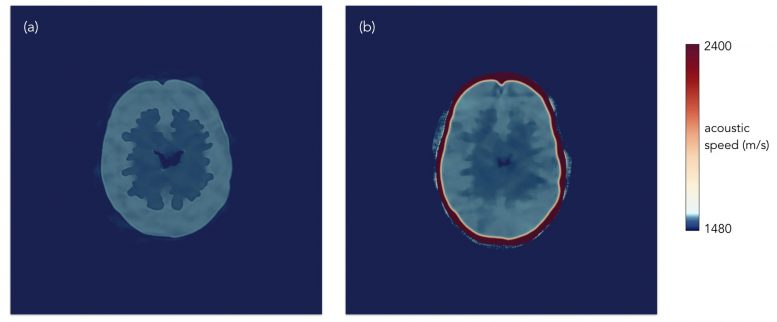
Comparison of the reconstruction results with the proposed technique (full-waveform inversion, FWI) for the soft tissue phantom without the skull mimic (a), and with the skull mimic (b). Differences in shape between the images are due to changes in the soft phantom as it becomes compressed and deformed during insertion inside the rigid skull sleeve. Credit: Guasch et al. / Imperial College London
They created detailed computer simulations based on the properties of different types of human brain tissue to establish that sound waves would be effective for composing high-resolution images of the brain.
Dr. Guasch said: “This is the first time FWI has been applied to the task of imaging inside a human skull. FWI is normally used in geophysics to map the structure of the Earth, but our collaborative, multidisciplinary team of earth scientists, bioengineers and neurologists are using it to create a safe, cheap and portable method of generating 3D ultrasound images of the human brain.”
Potential clinical use
Magnetic Resonance Imaging (MRI) is generally the best method for obtaining high-resolution images of the brain, and its use is currently essential to the investigation of many neurological disorders including stroke, brain cancer, and brain injury.
Nonetheless, MRI requires large, complex, expensive, non-portable machines cooled to three degrees above absolute zero, and it cannot be used on patients for whom the presence of metallic implants or foreign bodies cannot be scrupulously ruled out. This makes emergency use in patients with potentially altered consciousness, such as those suspected of stroke, difficult or impossible.
The researchers say that if it proves successful in human trials, their device will overcome these obstacles.
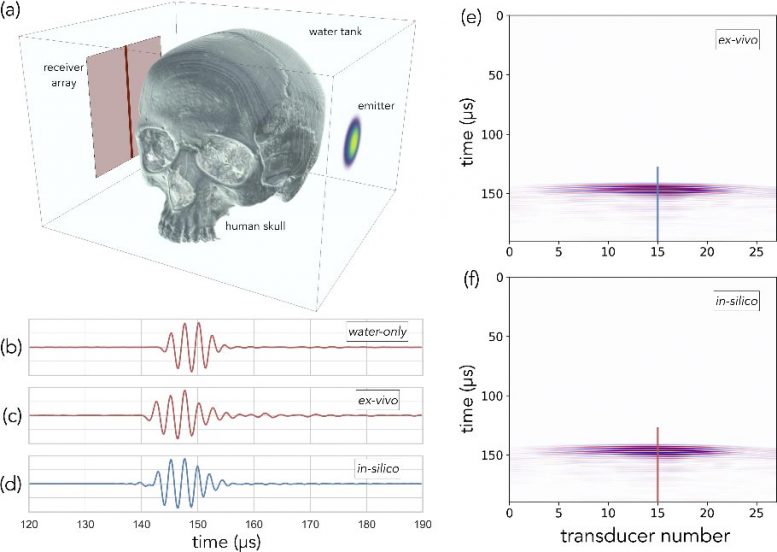
Ex vivo and in silico data after transmission across the head. a) The geometry of the ex vivo laboratory experiment. b) Data recorded in the laboratory by the central transducer without the skull present. c) The equivalent ex vivo data recorded with the skull. d) The equivalent in silico data with the skull. e) Laboratory ex vivo data recorded on a finely sampled linear array with the skull. f)The equivalent numerical data simulated in 3D. The physical skull and the numerical model are nominally the same, but differ in detail, and the numerical model does not include the effects of scattering by the physical transducers and their supporting hardware. Figures b–d are normalized to their largest amplitude; the un-normalized amplitudes in b are about five times larger than those in c. Credit: Guasch et al.
Study co-author Professor Parashkev Nachev, of UCL, said: “This is a vivid illustration of the remarkable power of advanced computation in medicine. Combining algorithmic innovation with supercomputing could enable us to retrieve high-resolution images of the brain from safe, relatively simple, well-established physics: the transmission of soundwaves through human tissue.
“The practicalities of MRI will always limit its applicability, especially in the acute setting, where timely intervention has the greatest impact. Neurology has been waiting for a new, universally applicable imaging modality for decades: full-waveform inversion could well be the answer.”
Next, the researchers will build a new prototype for live imaging of normal human brains as the first step to a device that could be evaluated in clinical contexts.
Reference: “Full-waveform inversion imaging of the human brain” by Lluís Guasch, Oscar Calderón Agudo, Meng-Xing Tang, Parashkev Nachev and Michael Warner, 6 March 2020, npj Digital Medicine.
DOI: 10.1038/s41746-020-0240-8

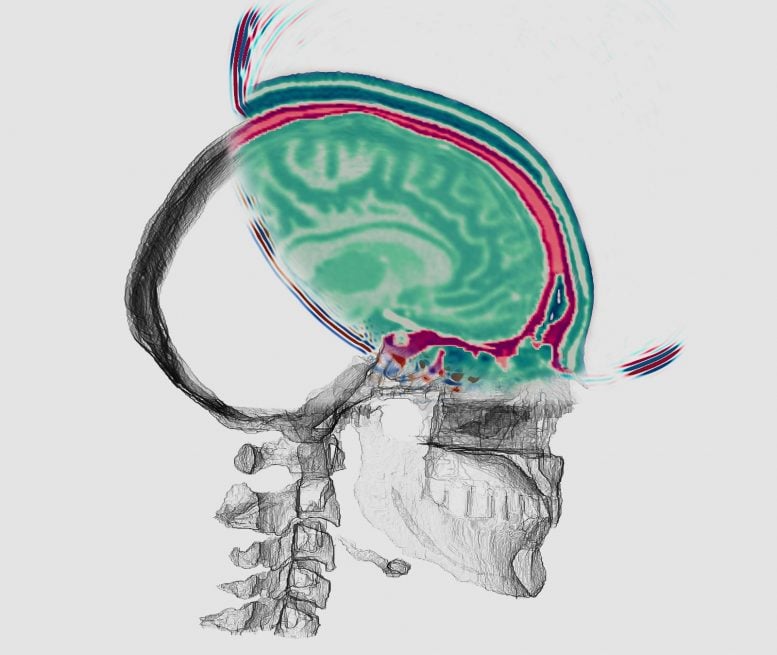
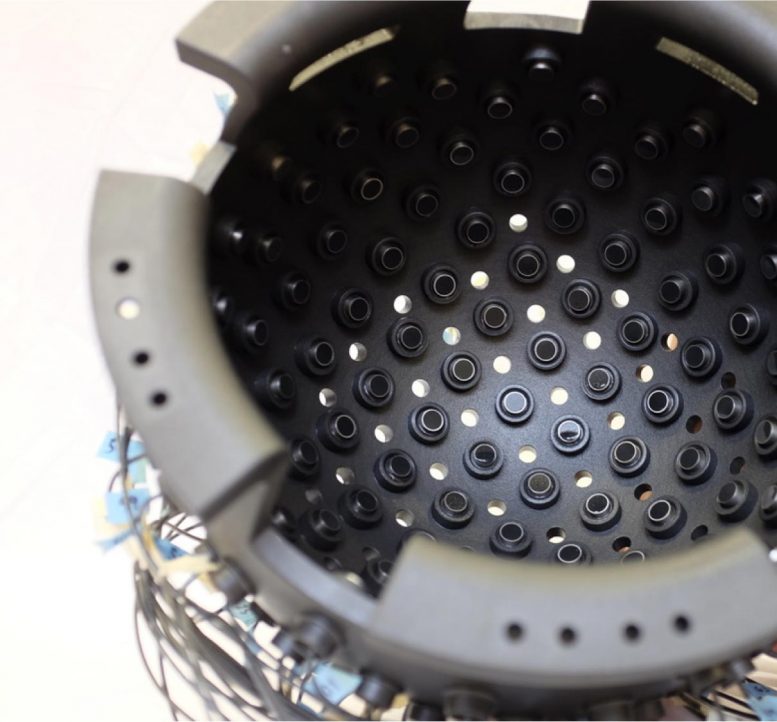



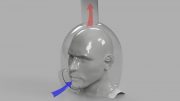




Be the first to comment on "Highly Detailed Images of the Human Brain Using Revolutionary Seismic Imaging Technology"